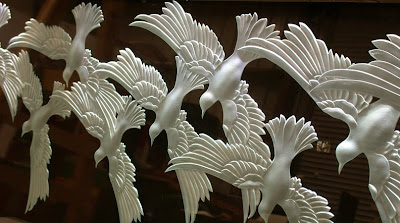
True art is created by the human hand. That’s why we use no machine carving, laser etching, or chemical processes to create the Art Glass Donor Walls, Tributes and Signage that we are famous for. All of our award-winning pieces are meticulously carved and etched by hand.
How do you carve and etch a material as delicate as glass? Ironically, it’s done by SANDBLASTING.
Whether we are doing bas-relief carving to create the alabaster look of birds in flight or chisel-carving true V-cut letterforms (a monument-style technique once only possible in stone), the work is all done by directing narrow streams of air-propelled particles (originally, sand was used) to the back or front of thick sheets of crystal and glass. By altering the speed of the air, the size of the nozzle, the angle at which the nozzle is held, and how long the stream of “sand” is directed at a given area, a marvelous range of different effects can be created.Christina Wallach Amri began her career over 35 years ago in Paris, where she apprenticed with a fourth-generation family of glass artisans. Among other projects, she worked on restoring the famous stained glass windows of Chartres cathedral.
When Christina returned to the U.S. and founded Wallach Glass Studio (now Amri studio), she began developing techniques for etching and carving glass to resemble the timeless and elegant stone monuments she saw in Europe. She also brought her experience and studies as an art major at U.C. Berkeley into the sandblasting cabinet and began truly sculpting in glass. Now we are the deepest bas-relief glass carvers in the U.S., sometimes working on panels as thick as a full inch.
In the late 1990s, with the invention of sophisticated photo manipulation software, Amri Studio began working to find a way to increase the delicacy of its carved lettering and artwork and to etch highly detailed photo portraits in crystal and glass. The biggest hurdle to overcome was the fact that when converting a photo into dots, a process they call dithering, the image loses a lot of detail.
We restore the fine details in a highly skillful, artistic and technical process we’ve developed that takes up to 20 hours per photo. When the resulting image is then carved into crystal or glass, each tiny dot is scooped out by a blast of “sand,” creating a tiny bowl shape. When the sandblasted image is edge-lit by LEDs, the little bowls collect the light as it travels through the crystal (which acts as a fiber optic) and the image looks dramatically three-dimensional.
Thanks to the proprietary techniques we’ve developed for creating our signature chisel-cut, three-dimensional lettering and highly detailed photo portraits, our Art Glass panels -- whether they are Donor Recognition, Tributes or Corporate Signage -- brilliantly catch the light and read crisply at quite a distance with either ambient lighting, spot lighting and/or edge-mounted LEDs.




















No comments:
Post a Comment